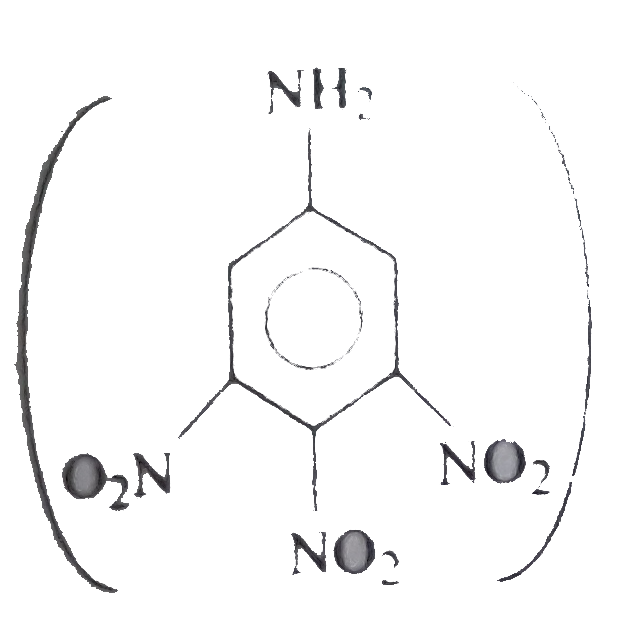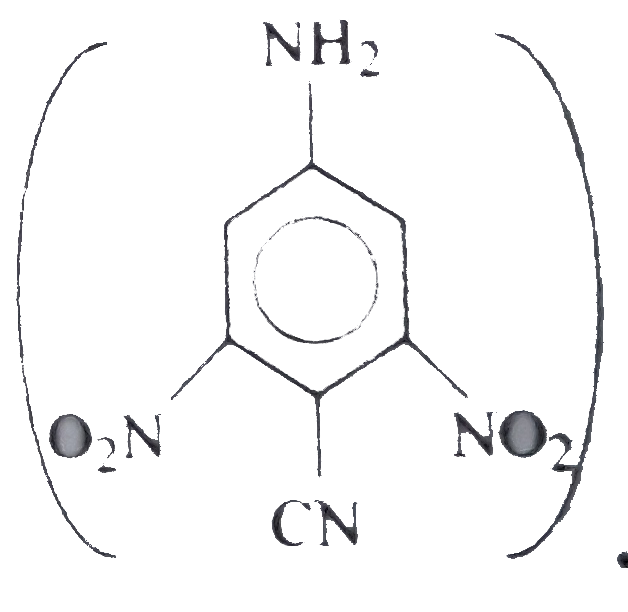Which of the following statement (s) is/are correct ?
3,4,5−Trinitroaniline (I)  than 4-cyano-3,5-dinitroaniline (II)
than 4-cyano-3,5-dinitroaniline (II) 
(II) is more basic than (I)
(I) is more basic than (II) due to steric inhibition of resonance in (I)
There is no steric inhibition resonance in (II)
The correct Answer is:A, C, D
To determine which of the statements regarding the basicity of the compounds is correct, we need to analyze the effects of the substituents on the aniline derivatives mentioned in the question.
1. Identify the Compounds:
- The first compound is 3,4,5-trinitroaniline.
- The second compound is 4-cyano-3,5-dinitroaniline.
2. Understand Basicity:
- Basicity in amines is primarily determined by the availability of the lone pair of electrons on the nitrogen atom for donation. The presence of electron-withdrawing groups (EWGs) like nitro (NO2) and cyano (CN) decreases basicity by stabilizing the lone pair through resonance or inductive effects.
3. Analyze the First Compound (3,4,5-trinitroaniline):
- This compound has three nitro groups attached to the benzene ring.
- The nitro groups are strong electron-withdrawing groups and will decrease the basicity of the amine.
- However, due to the arrangement of the nitro groups, the one at the meta position does not participate in resonance with the lone pair of the NH2 group. This leads to steric inhibition of resonance, making the lone pair more available for donation.
4. Analyze the Second Compound (4-cyano-3,5-dinitroaniline):
- This compound has two nitro groups and one cyano group.
- The cyano group is planar and can participate in resonance with the benzene ring.
- The presence of the cyano group allows the lone pair on the NH2 group to be delocalized into the ring, thus making it less available for donation and decreasing its basicity.
5. Compare Basicity:
- Since the first compound has steric inhibition of resonance, the lone pair on the NH2 group is more available for donation compared to the second compound, where the lone pair is delocalized due to resonance with the cyano group.
- Therefore, 3,4,5-trinitroaniline is more basic than 4-cyano-3,5-dinitroaniline.
6. Evaluate the Statements:
- Statement 1: "3,4,5-trinitroaniline is more basic than 4-cyano-3,5-dinitroaniline." - Correct
- Statement 2: "2 is more basic than 1." - Incorrect (as we established that 1 is more basic).
- Statement 3: "1 is more basic than 2 due to steric inhibition of resonance in 1." - Correct
- Statement 4: "There is no steric inhibition of resonance in 2." - Correct (the cyano group is planar and participates in resonance).
Final Conclusion:
- The correct statements are:
- Statement 1: Correct
- Statement 2: Incorrect
- Statement 3: Correct
- Statement 4: Correct
- The first compound is 3,4,5-trinitroaniline.
- The second compound is 4-cyano-3,5-dinitroaniline.
- Basicity in amines is primarily determined by the availability of the lone pair of electrons on the nitrogen atom for donation. The presence of electron-withdrawing groups (EWGs) like nitro (NO2) and cyano (CN) decreases basicity by stabilizing the lone pair through resonance or inductive effects.
- This compound has three nitro groups attached to the benzene ring.
- The nitro groups are strong electron-withdrawing groups and will decrease the basicity of the amine.
- However, due to the arrangement of the nitro groups, the one at the meta position does not participate in resonance with the lone pair of the NH2 group. This leads to steric inhibition of resonance, making the lone pair more available for donation.
- This compound has two nitro groups and one cyano group.
- The cyano group is planar and can participate in resonance with the benzene ring.
- The presence of the cyano group allows the lone pair on the NH2 group to be delocalized into the ring, thus making it less available for donation and decreasing its basicity.
- Since the first compound has steric inhibition of resonance, the lone pair on the NH2 group is more available for donation compared to the second compound, where the lone pair is delocalized due to resonance with the cyano group.
- Therefore, 3,4,5-trinitroaniline is more basic than 4-cyano-3,5-dinitroaniline.
- Statement 1: "3,4,5-trinitroaniline is more basic than 4-cyano-3,5-dinitroaniline." - Correct
- Statement 2: "2 is more basic than 1." - Incorrect (as we established that 1 is more basic).
- Statement 3: "1 is more basic than 2 due to steric inhibition of resonance in 1." - Correct
- Statement 4: "There is no steric inhibition of resonance in 2." - Correct (the cyano group is planar and participates in resonance).
- The correct statements are:
- Statement 1: Correct
- Statement 2: Incorrect
- Statement 3: Correct
- Statement 4: Correct
Topper's Solved these Questions
- GENERAL ORGANIC CHEMISTRYBOOK - CENGAGE CHEMISTRY ENGLISHCHAPTER - GENERAL ORGANIC CHEMISTRYEXERCISE - Single Correct
23 Videos
- GENERAL ORGANIC CHEMISTRYBOOK - CENGAGE CHEMISTRY ENGLISHCHAPTER - GENERAL ORGANIC CHEMISTRYEXERCISE - Assertion-Reasoning
5 Videos
- GENERAL ORGANIC CHEMISTRYBOOK - CENGAGE CHEMISTRY ENGLISHCHAPTER - GENERAL ORGANIC CHEMISTRYEXERCISE - Comprehension
20 Videos
- CLASSIFICATION AND NOMENCLATURE OF ORGANIC COMPOUNDSBOOK - CENGAGE CHEMISTRY ENGLISHCHAPTER - CLASSIFICATION AND NOMENCLATURE OF ORGANIC COMPOUNDSEXERCISE - Analytical and Descriptive Type
3 Videos
- HYDROGEN, WATER AND HYDROGEN PEROXIDEBOOK - CENGAGE CHEMISTRY ENGLISHCHAPTER - HYDROGEN, WATER AND HYDROGEN PEROXIDEEXERCISE - Subjective Archive (Subjective)
3 Videos
Similar Questions
Knowledge Check
Which of the following statement(s) is not correct?
AThe electronic configuration of Cr is [Ar] 3d54s1 (At. No. of Cr= 24).BThe magnetic quantum number may have a negative, value.CIn silver atom, 23 electrons have a spin of one type and 24 of the opposite type. (At. no. of Ag =47).DThe oxidation state of nitrogen in N3H is -3.
Which of the following statement(s) is/are not correct?
View SolutionWhich of the following statement(s) is/are not correct.
View SolutionWhich of the following statement(s) is/are not correct?
View SolutionGiven a+b+c+d=0. Which of the following statements(s) is (are) correct?
View SolutionWhich of the following statements (s) are not correct?
View SolutionWhich of the following statement (s) are (are) correct?
View SolutionWhich one of the following statement (s) is (are) correct?
View Solution
